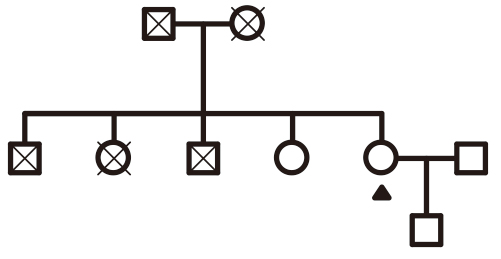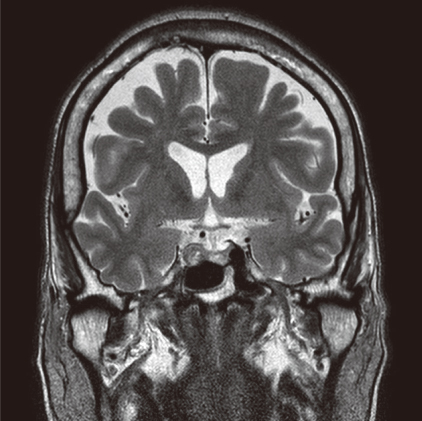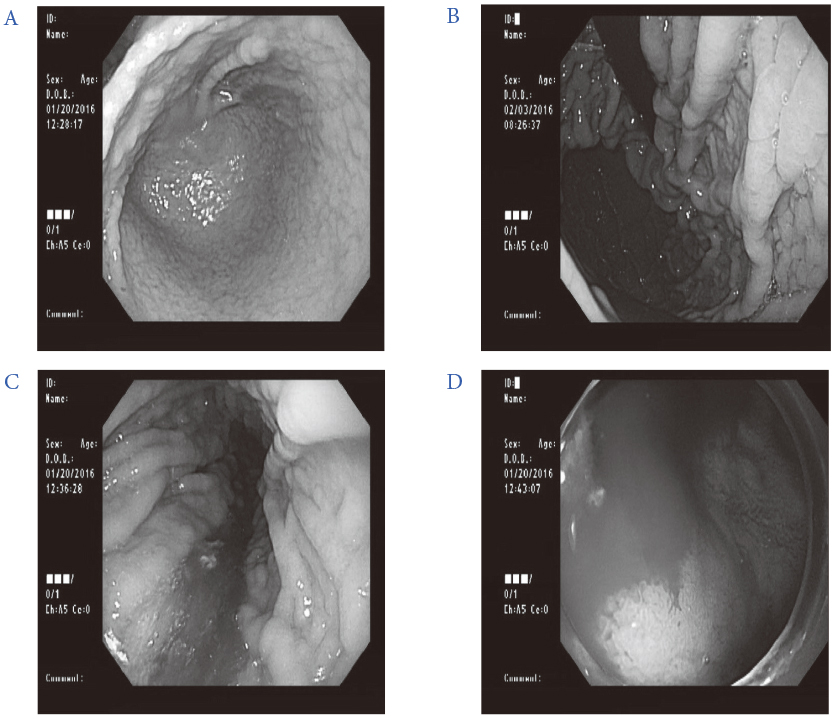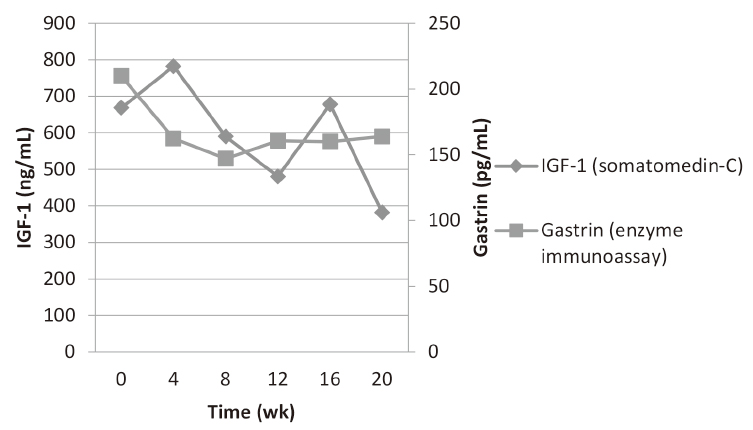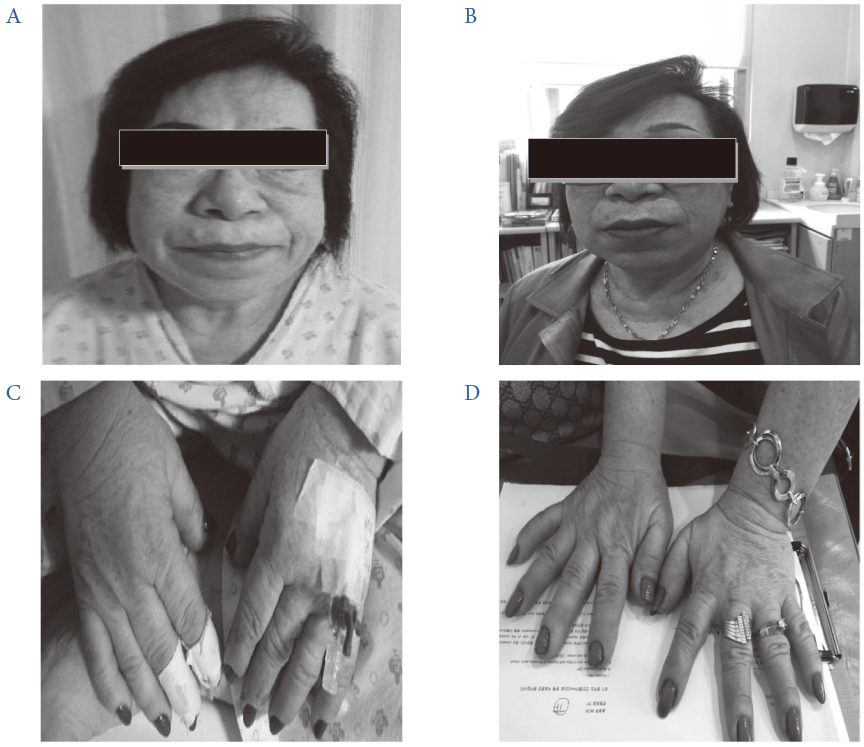J Korean Diabetes.
2017 Jun;18(2):125-133. 10.4093/jkd.2017.18.2.125.
A Case of Multiple Endocrine Neoplasia Type 1 in Type 2 Diabetes Mellitus with Poor Glycemic Control
- Affiliations
-
- 1Division of Endocrinology and Metabolism, Department of Internal Medicine, Sejong General Hospital, Bucheon, Korea. drangelkr@hanmail.net
- KMID: 2385575
- DOI: http://doi.org/10.4093/jkd.2017.18.2.125
Abstract
- The primary causes of uncontrolled diabetes are poor life-style, infection, ischemic heart disease and inappropriate usage of oral anti-diabetic agents and insulin. Supplementary causes are stroke, acute pancreatitis and endocrine diseases. Multiple endocrine neoplasia type 1 (MEN 1) is an autosomal dominant syndrome characterized by primary hyperparathyroidism, pituitary neoplasia, and foregut lineage neuroendocrine tumors, and is associated with increased glucose levels. We present a case of a 69-year-old woman who had polyuria, polydipsia, weight loss and hyperglycemia over 6 months. She had hypertrophy of the face, hand, and foot, and active bleeding and large folds were observed in the stomach and duodenum upon esophagogastroduodenoscopy. She also had high levels of IGF-1 and gastrin and got the failure of growth hormone suppression after an oral glucose load (75 g). These findings suggested a diagnosis of acromegaly and gastrinoma, which was clinically diagnosed along with MEN 1. The patient improved glycemic control and symptoms after being treated with somatostatin analogues and insulin therapy over a 5-month follow-up period. Here, we report a case of MEN 1 in type 2 diabetes mellitus with a poorly controlled blood glucose level. Clinicians should consider endocrine disease in patients with poor glycemic control in diabetes.
MeSH Terms
-
Acromegaly
Aged
Blood Glucose
Diabetes Mellitus*
Diabetes Mellitus, Type 2
Diagnosis
Duodenum
Endocrine System Diseases
Endoscopy, Digestive System
Female
Follow-Up Studies
Foot
Gastrinoma
Gastrins
Glucose
Growth Hormone
Hand
Hemorrhage
Humans
Hyperglycemia
Hyperparathyroidism, Primary
Hypertrophy
Insulin
Insulin-Like Growth Factor I
Multiple Endocrine Neoplasia Type 1*
Multiple Endocrine Neoplasia*
Myocardial Ischemia
Neuroendocrine Tumors
Pancreatitis
Polydipsia
Polyuria
Somatostatin
Stomach
Stroke
Weight Loss
Blood Glucose
Gastrins
Glucose
Growth Hormone
Insulin
Insulin-Like Growth Factor I
Somatostatin
Figure
Reference
-
1. Kim DJ. The epidemiology of diabetes in Korea. Diabetes Metab J. 2011; 35:303–308.
Article2. Marx SJ, Wells SA. Multiple endocrine neoplasia. In : Melmed S, Polonsky K, Larsen PR, Kronenberg H, editors. Williams textbook of endocrinology. 12th ed. Philadelphia: Elsevier;2011. p. 1728–1767.3. Morelli A, Falchetti A, Martineti V, Becherini L, Mark M, Friedman E, Brandi ML. MEN1 gene mutation analysis in Italian patients with multiple endocrine neoplasia type 1. Eur J Endocrinol. 2000; 142:131–137.
Article4. Lemos MC, Thakker RV. Multiple endocrine neoplasia type 1(MEN1): analysis of 1336 mutations reported in the first decade following identification of the gene. Hum Mutat. 2008; 29:22–32.
Article5. Stabile BE, Passaro E Jr. Recurrent pepti culcer. Gastroenterology. 1976; 70:124–135.6. Hirschowitz BI. Zollinger-Ellison syndrome: pathogenesis, diagnosis, and management. Am J Gastroenterol. 1997; 92:4 Suppl. 44S–48S. discussion 49S-50S.7. Orloff SL, Debas HT. Advances in the management of patients with Zollinger-Ellison syndrome. Surg Clin North Am. 1995; 75:511–524.
Article8. Bengtsson BA, Edén S, Ernest I, Odén A, Sjögren B. Epidemiology and long-term survival in acromegaly. A study of 166 cases diagnosed between 1955 and 1984. Acta Med Scand. 1988; 223:327–335.
Article9. Ezzat S, Melmed S. Clinical review 18: are patients with acromegaly at increased risk for neoplasia. J Clin Endocrinol Metab. 1991; 72:245–249.10. Barzilay J, Heatley GJ, Cushing GW. Benign and malignant tumors in patients with acromegaly. Arch Intern Med. 1991; 151:1629–1632.
Article11. Ganda OP, Bachman ES. Diabetes secondary to endocrinopathies. In : Porte D, Sherwin RS, Baron A, Ellenberg M, Rifkin H, editors. Ellenberg and Rifkin's diabetes mellitus. 6th ed.New York: McGraw-Hill;2003. p. 425.12. Melmed S. Medical progress: acromegaly. N Engl J Med. 2006; 355:2558–2573.13. Webb SM, Casanueva F, Wass JA. Oncological complications of excess GH in acromegaly. Pituitary. 2002; 5:21–25.
- Full Text Links
- Actions
-
Cited
- CITED
-
- Close
- Share
- Similar articles
-
- Scintigraphic evaluation of multiple endocrine neoplasia type 2 (MEN type 2)
- Imaging Finding of Multiple Endocrine Neoplasia Type 1: Case Report
- A Case of Multiple Endocrine Neoplasia type 3 With Multiple Mucosal Neuroma
- Growth Status in Children with Type 1 and 2 Diabetes Mellitus
- Multiple Endocrine Neoplasia 2A Detected by Peptic Ulcer Perforation with Hypercalcemia

